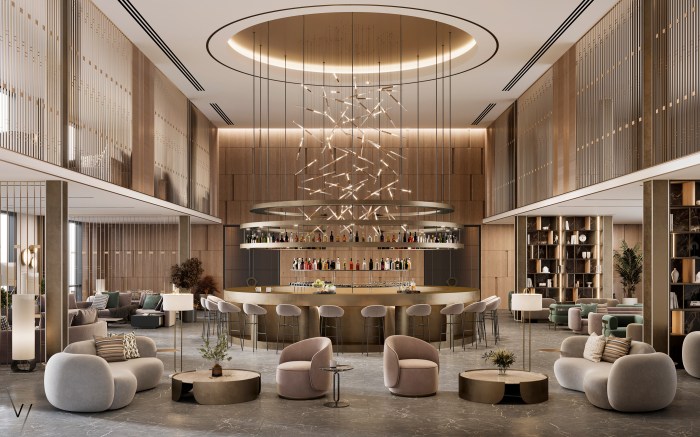Exploring Hotel Interior Design: Key Elements and Signature Styles

Embark on a journey through the world of hotel interior design, where every element plays a vital role in creating a welcoming and luxurious ambiance for guests. From lighting to color schemes, furniture selection to incorporating local culture, this topic delves into the intricate details that make each hotel unique.
Elements of Hotel Interior Design
Hotel interior design is a crucial aspect of creating a welcoming and comfortable environment for guests. Several key elements contribute to a well-designed hotel interior, including lighting, furniture selection, and color schemes.
Lighting in Hotel Interior Design
Lighting plays a crucial role in enhancing the ambiance of a hotel interior. Proper lighting can create a warm and inviting atmosphere, while also highlighting key design elements within the space. Whether it's natural light streaming in through large windows or strategically placed artificial lighting, the right lighting can set the mood for guests.
Furniture Selection in Hotel Interior Design
The selection of furniture is essential in creating a comfortable and stylish hotel interior. Furniture should not only be aesthetically pleasing but also functional and durable to withstand the wear and tear of constant use. The choice of furniture pieces, from seating to beds, can greatly impact the overall look and feel of the space.
Color Schemes in Hotel Interior Design
Color schemes are another important element in hotel interior design, as they can evoke different moods and emotions in guests. Whether it's calming blues and greens in a spa-like setting or bold and vibrant colors in a trendy boutique hotel, the use of color can help create a cohesive and inviting atmosphere throughout the property.
Incorporating Functional Spaces
Hotel interiors are meticulously designed to optimize space for various functions, ensuring a seamless and efficient experience for guests. From the reception area to the dining spaces, every corner is thoughtfully laid out to cater to different needs and activities.
Reception Area
In the reception area, layout considerations focus on creating a welcoming and efficient space for guests to check-in and out seamlessly. A modern approach involves incorporating self-check-in kiosks and digital concierge services to streamline the process. Comfortable seating areas and stylish decor enhance the overall guest experience.
Lobby
The lobby serves as a multifunctional space where guests can relax, socialize, or work. Design elements such as modular furniture arrangements and flexible seating options allow for versatility in the usage of the area. Integrated charging stations and high-speed Wi-Fi ensure that guests can stay connected while enjoying the hotel amenities.
Rooms
Hotel rooms are designed to provide a comfortable and functional living space for guests. Smart room technology, such as keyless entry systems and in-room automation controls, offer convenience and enhance the overall guest experience. Efficient storage solutions and ergonomic furniture layouts maximize space utilization without compromising on comfort.
Dining Spaces
Dining spaces in hotels are designed to create a memorable culinary experience for guests. Open kitchen concepts, interactive cooking stations, and innovative menu displays enhance the dining ambiance. Sustainable practices, such as using locally sourced ingredients and eco-friendly packaging, contribute to a more environmentally conscious dining experience.
Technology Integration
Innovative ways to seamlessly integrate technology into hotel interior design include smart lighting systems, interactive digital displays, and personalized guest interfaces. These technological advancements not only enhance the guest experience but also improve operational efficiency for hotel staff.
Sustainable Elements
Incorporating sustainable and eco-friendly elements in hotel interiors is crucial for reducing environmental impact and creating a healthier space for guests. This can be achieved through energy-efficient lighting, water-saving fixtures, recycled materials, and green building certifications. Sustainable practices not only benefit the environment but also contribute to a positive brand image for the hotel.
Signature Styles and Themes
Hotel interior design often showcases signature styles and themes that set them apart from one another. These styles not only reflect the brand and image of the hotel but also create a unique experience for guests.
Popular Interior Design Styles
Hotels frequently incorporate popular interior design styles to create a specific ambiance and atmosphere. Some common styles include:
- Modern and Minimalist: Clean lines, simple furniture, and neutral colors create a sleek and contemporary look.
- Classic and Traditional: Rich fabrics, ornate details, and elegant furnishings evoke a sense of luxury and sophistication.
- Eclectic and Bohemian: Mixing different textures, patterns, and colors for a vibrant and artistic feel.
- Industrial and Urban: Exposed brick, metal accents, and raw materials for a trendy and edgy aesthetic.
Incorporating Local Culture and Heritage
Many hotels draw inspiration from the local culture and heritage of their location to infuse authenticity into their interior design. This can include incorporating traditional artwork, textiles, or architectural elements that reflect the history and identity of the area.
Role of Artwork, Decor, and Accessories
Artwork, decor, and accessories play a crucial role in adding character and personality to hotel interiors. From statement pieces to subtle accents, these elements contribute to the overall theme and ambiance of the space. Unique and carefully selected pieces can create a memorable experience for guests.
Unique and Creative Themes
Some hotels go above and beyond by implementing unique and creative themes that truly set them apart. For example, a hotel designed like a tropical oasis with lush greenery and water features, or a boutique hotel themed around a specific time period or cultural movement.
These imaginative themes elevate the guest experience and leave a lasting impression.
Creating a Luxurious Experience
When it comes to designing hotel interiors to create a luxurious experience, attention to detail is key. Every element, from the textures to the materials used, plays a significant role in setting the tone for a high-end ambiance.
Design Elements for Luxury
One of the design elements that contribute to a sense of luxury in hotel interiors is the use of high-quality materials such as marble, granite, and fine woods. These materials not only exude elegance but also ensure durability and longevity.
- Rich Textures: Incorporating plush fabrics like velvet and silk can add a sense of opulence to the space.
- Statement Lighting: Luxurious chandeliers or designer light fixtures can elevate the ambiance and create a sophisticated atmosphere.
- Customized Furnishings: Tailored furniture pieces and bespoke decor items can add a personalized touch to the design, making guests feel pampered.
Attention to Detail
Attention to detail in amenities and furnishings is crucial for enhancing the overall luxurious experience in a hotel. From high-thread-count linens to designer toiletries, every small touch can elevate the guest's stay.
- Spa-Like Bathrooms: Luxurious bathrooms with features like rain showers, marble vanities, and premium bath products can make guests feel indulged.
- High-Quality Bedding: Plush mattresses, soft linens, and a selection of pillows can ensure a restful night's sleep for guests.
- Artwork and Decor: Fine art pieces, sculptures, and tasteful decor accents can add a touch of sophistication to the space.
Catering to Different Target Markets
Hotel interior design can cater to different target markets by understanding their preferences for luxury. For example, business travelers may appreciate well-equipped workspaces and technology integration, while leisure travelers may seek relaxation areas and recreational amenities.
- Business-Friendly Spaces: Incorporating ergonomic furniture, high-speed Wi-Fi, and conference facilities can cater to the needs of business travelers.
- Wellness Retreats: Designing spa facilities, fitness centers, and wellness programs can attract guests looking for a luxurious wellness retreat.
- Bespoke Experiences: Offering personalized services, exclusive dining options, and unique experiences can cater to luxury travelers seeking a bespoke stay.
Closing Notes

As we conclude our exploration of hotel interior design, it becomes evident that the art of creating a luxurious experience goes beyond aesthetics. It involves a thoughtful blend of functionality, style, and innovation to cater to diverse tastes and preferences.
Dive into the world of hotel interior design and discover the magic that transforms spaces into unforgettable experiences.
Detailed FAQs
How does lighting impact the ambiance of a hotel interior?
Lighting plays a crucial role in setting the mood and enhancing the overall atmosphere of a hotel interior. Proper lighting can create a warm, inviting space or a vibrant, energetic environment.
What are some innovative ways to integrate technology into hotel interior design?
Hotels are incorporating technology seamlessly by using smart room controls, interactive displays, and automated systems to enhance guest experiences and improve operational efficiency.
How do hotels incorporate local culture into their interior design themes?
Hotels often showcase local art, traditional craftsmanship, and architectural elements to reflect the unique culture and heritage of the destination, creating an authentic and immersive experience for guests.

